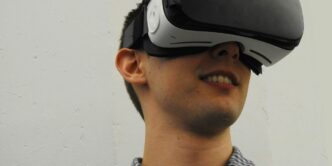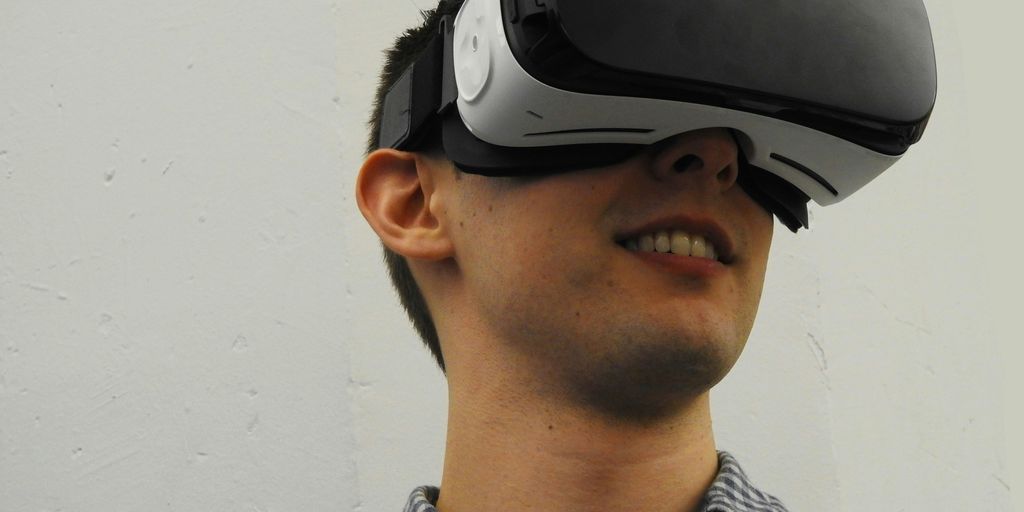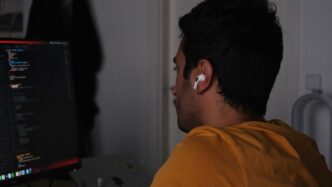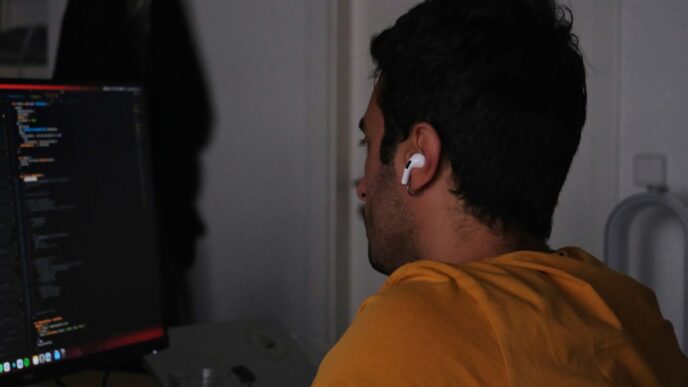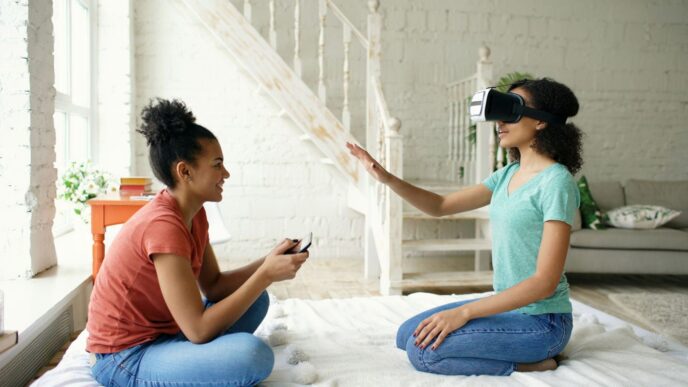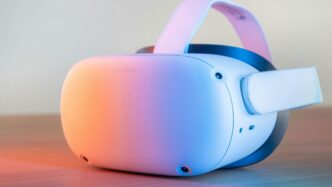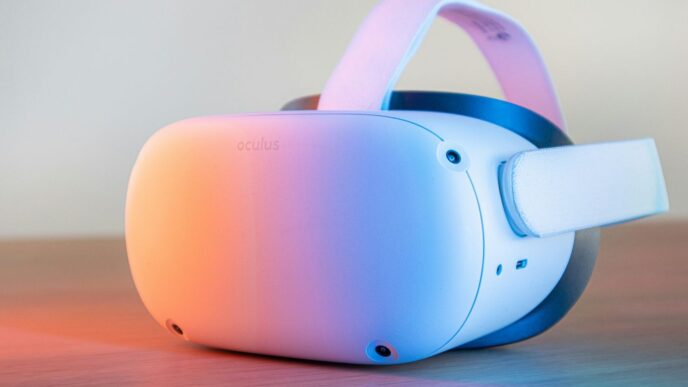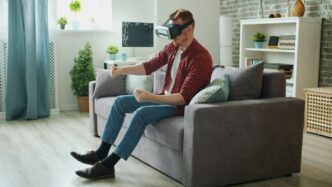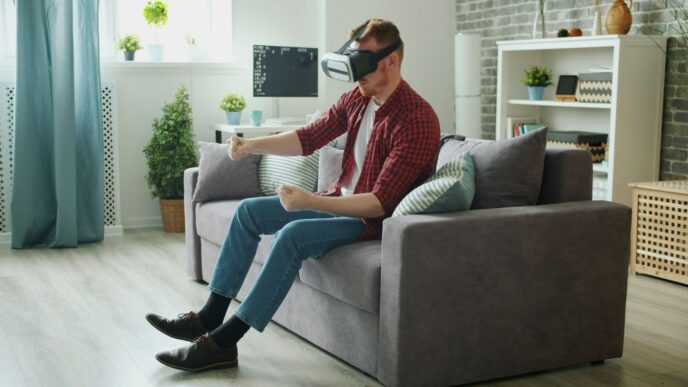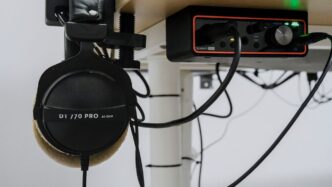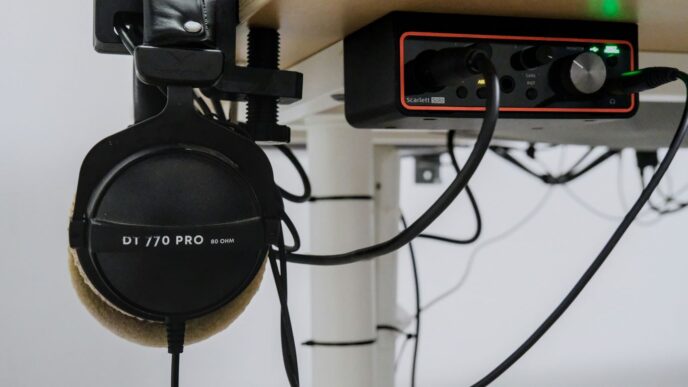Virtual reality (VR) is really changing how we make and see digital stuff. It’s not just for games anymore; it’s popping up everywhere, from how we learn to how we watch movies. Because of this, getting good at making things move in VR, or VR animation, is becoming a big deal. We’re going to look at the tools and tricks you need to know to create cool, immersive experiences that pull people right into the virtual world.
Key Takeaways
- Getting good with VR animation tools is important for making immersive experiences.
- Tools like SimLab are pretty easy to use for both new and experienced creators.
- Knowing how to use keyframes and make animations smooth is a big part of VR animation.
- Using advanced tricks like scene states and visual effects can make VR projects much better.
- Making sure your VR projects run well is super important for users.
Understanding The Importance Of VR Animation

Virtual reality (VR) isn’t just about looking at things anymore; it’s about being in them. And animation is what makes these virtual worlds feel alive and believable. Think about it: VR is popping up everywhere, from how we learn in schools to how we experience entertainment. Because of this, knowing how to animate for VR is becoming a really useful skill. It’s not like traditional animation where you just watch something happen. In VR, the animation needs to react to you, the person experiencing it. This means characters might turn to look at you, or objects might move when you get close. It’s a whole different ballgame.
The Rise Of Virtual Reality In Media And Education
VR is changing the game for media and learning. Imagine being able to walk through ancient Rome for a history lesson or explore the human body from the inside. VR makes these kinds of experiences possible. As the technology gets better and more people can access it, its use in schools and for entertainment is only going to grow. This means there’s a real need for people who can create these virtual experiences.
Why Skill Development In VR Technology Is Crucial
As VR gets more advanced, so does the need for people who know how to build things for it. Getting good with VR animation tools can lead to some pretty cool jobs in game design, movies, and even education. Being able to create these interactive VR worlds means you can really bring your ideas to life. Whether you’re making a game or a training program, these skills are key to making something that people will enjoy and remember. It’s about making digital things feel real.
Mastering VR Animation Tools For Immersive Experiences
Tools like SimLab are making it easier to create these VR animations. They have features that help you build scenes and make things move without a super steep learning curve. Learning to use these tools well is how you go from just making a VR scene to making one that truly pulls people in. You can build environments, set up animations using timelines and keyframes, and even adjust how things look with materials and lighting. It’s all about putting the pieces together to create something that feels real and engaging for the person using it. You can find out more about 3D animation transforming VR.
Getting Started With VR Animation Tools
Getting started with VR animation tools can feel a bit daunting, but honestly, it’s more about getting comfortable with the software than anything else. Think of it like learning a new creative program, but instead of a mouse and keyboard, you’re using your hands in a virtual space. Many tools are designed to be pretty intuitive, so you can jump right in.
Exploring SimLab’s Intuitive Interface
SimLab is a good place to start because its interface is pretty straightforward. When you first open it up, you’ll see a main workspace where your 3D scene will be. There are usually toolbars around the edges with different functions. Don’t be afraid to click around and see what happens. You’ll find tools for importing models, manipulating objects, and setting up animations. It’s all about getting a feel for where things are and what they do. You can import existing 3D models or create simple shapes right within the program. Getting familiar with the basic layout is the first step to making anything happen.
Scene Building and Arrangement in VR
This is where you actually build your virtual world. You’ll be importing 3D models – maybe characters, props, or environments – and placing them in your scene. Think about how you want things to look and interact. You can move, rotate, and scale objects using the VR controllers. It’s like arranging furniture, but in a digital dimension. You can also group objects together, which is handy for managing complex scenes. For example, if you have a character with several accessories, grouping them makes it easier to move the whole ensemble.
Utilizing the Animation Timeline and Keyframes
This is the heart of animation. The timeline is usually a visual representation of time, broken down into frames. Keyframes are specific points in time where you define the state of an object – its position, rotation, or scale. When you set a keyframe, the software remembers that state. Then, you move to another point in time, change the object’s state, and set another keyframe. The software then automatically calculates the movement between those keyframes, creating the animation. It’s a bit like drawing a few key poses for a character and letting the computer fill in the in-between movements. You can adjust how these movements happen, making them smooth or abrupt.
Mastering Material and Lighting Tools
Once you have your animation set up, you’ll want to make it look good. This is where materials and lighting come in. Materials define how surfaces look – are they shiny, rough, metallic, or transparent? You can apply different textures and colors to your objects. Lighting is just as important; it sets the mood and helps define the shapes in your scene. You can add different types of lights, like spotlights or ambient light, and adjust their intensity and color. Playing with these settings can drastically change the feel of your VR experience. For instance, using dim, colored lights can create a mysterious atmosphere, while bright, even lighting might be better for a clear educational demonstration. You can find more about creating stunning visuals using tools like Blender.
Here’s a quick rundown of what you’ll typically find:
- Materials: Control surface appearance (color, texture, shininess).
- Lighting: Add and adjust light sources to illuminate the scene.
- Textures: Apply image files to surfaces for added detail.
- Post-Processing: Effects like bloom or color correction to fine-tune the final look.
Essential Techniques For Compelling VR Animation
Alright, so you’ve got the hang of the tools, but how do you actually make something cool in VR? It’s not just about moving stuff around; it’s about making it feel right. Think about how things move in the real world. When a ball rolls, it speeds up and slows down, right? That’s called interpolation, and it’s super important for making animations look natural, not jerky. You want your virtual characters to move smoothly, not like they’re on a choppy video feed.
VR also changes how we tell stories. Instead of a movie screen, your story is everywhere. This means you need to think about spatial narrative design. Where do you hide clues? What happens if the user looks behind them? Sometimes, characters might even walk up behind you or appear in a different part of the virtual space. It’s like hiding Easter eggs, but for your plot.
And don’t forget about multi-layered and environmental storytelling. You can have a few things happening at once, letting the user pick what they want to focus on. Maybe there’s a conversation happening over here, and a mysterious object glowing over there. The environment itself can tell a story too. A broken window, a flickering light, or how furniture is arranged can hint at what happened before the user even arrived. It’s about using the whole virtual world as your canvas. Learning how to animate 3D models is a good place to start with these ideas.
Here are a few things to keep in mind:
- Smoothness is Key: Use keyframes and adjust the timing between them to avoid robotic movements.
- Space is Your Storyboard: Plan your narrative not just left-to-right, but up, down, and all around.
- Show, Don’t Just Tell: Let the environment and subtle animations convey information and mood.
Advanced Techniques For Dynamic VR Projects
Once you’ve got the hang of the basics, it’s time to really make your VR projects pop. We’re talking about techniques that move beyond simple animation and get users truly involved. Think about making things react to the user, not just play out a pre-set sequence. This is where VR animation gets exciting.
Utilizing Scene States for Interactive Content
Scene states are a really neat way to manage different versions of your virtual environment. Imagine a virtual product demo where a user can swap out colors or materials. Each of those changes can be a different ‘state’ of the scene. You can set up triggers so that when a user interacts with something, the scene shifts to a new state. This makes your VR experiences feel alive and responsive. It’s like having multiple versions of your world ready to go, all controlled by user actions. This approach is great for educational tools or interactive stories where choices matter.
Implementing Visual and Interactive Effects
This is where you add that extra layer of polish. Visual effects, like particle systems for dust motes in a sunbeam or subtle environmental animations, can really sell the atmosphere. Think about a VR nature scene; adding animated leaves falling or a gentle sway to the trees makes it feel much more real. Interactive effects are just as important. Maybe an object glows when you get close, or a button makes a sound and lights up when pressed. These small touches make the virtual world feel more tangible and engaging. It’s about creating a feedback loop where the user’s actions have a visible consequence in the virtual space. For anyone looking to get into this, checking out resources from places like Vancouver Film School can give you a good starting point for understanding these visual elements.
Enhancing Engagement Through Animation Interactivity
Making animation interactive is key to keeping people hooked in VR. Instead of just watching something happen, users can influence it. This could be as simple as a character turning to look at the user when they approach, or as complex as a physics-based puzzle where the user’s movements directly affect the outcome. The goal is to make the user feel like an active participant, not just a spectator. This kind of interaction can make learning more effective, games more compelling, and virtual tours more memorable. It’s about creating a sense of agency within the virtual environment.
Optimizing Performance For Seamless VR Experiences

Making VR animation run smoothly is a big deal. If it stutters or lags, people get motion sick or just plain annoyed. It ruins the whole point of being in a virtual world. So, we really need to pay attention to how our projects perform.
Ensuring Smooth Performance in VR Projects
Think of your VR project like a really busy highway. Lots of cars (data) are moving around, and if there are too many or they’re not organized, you get a traffic jam. In VR, that traffic jam is bad performance. We need to keep things flowing.
- Keep polygon counts reasonable: Super detailed models look great, but they can really slow things down. Try to use simpler shapes where you can, or optimize your models before bringing them into your VR scene. It’s a balancing act.
- Batch draw calls: This is a bit technical, but basically, it means telling the computer to draw multiple things at once instead of one by one. Fewer instructions mean faster rendering.
- Use efficient shaders: Shaders are what make things look shiny, bumpy, or transparent. Complex shaders can be very demanding on your graphics card. Stick to simpler ones if possible, or optimize the complex ones.
- Manage textures: Big, high-resolution textures eat up memory. Compress them and use them wisely. Not every surface needs a 4K texture, you know?
Tips For Optimizing VR Application Resources
Beyond the animation itself, the whole application needs to be efficient. This means looking at everything that uses up your computer’s power, like the CPU and GPU.
- Hardware Matters: You can’t expect a smooth experience on old or underpowered hardware. Make sure your system meets the recommended specs for VR development. A good graphics card and a decent processor are really important. For instance, many VR applications perform best with at least an NVIDIA GeForce GTX 1060 or similar. You can find more details on recommended specs for VR development.
- Profile Your Application: Use tools to see where your application is spending most of its time. Is it the physics? The AI? The rendering? Knowing this helps you focus your optimization efforts.
- Reduce Overdraw: This happens when you draw the same pixel multiple times in a single frame. Things like transparent objects layered on top of each other can cause this. Try to minimize overlapping transparent surfaces.
- Optimize Lighting: Real-time lighting can be very expensive. Bake lighting where possible, or use simpler lighting setups. Dynamic shadows, especially, can be a performance killer.
Ultimately, constant testing and profiling are key to identifying and fixing performance bottlenecks before your users ever see them. It’s an ongoing process, but getting it right makes all the difference for a good VR experience.
Future Trends Shaping VR Animation
The world of VR animation is always shifting, and keeping up with what’s next is pretty important if you want your work to feel fresh. We’re seeing some really cool stuff emerge that’s going to change how we create and experience animated worlds.
Volumetric Capture and Gaussian Splatting Advancements
Forget just moving objects around; we’re talking about capturing real-world moments and turning them into 3D animated scenes. Volumetric capture records a scene in 3D, so you can move around it like you’re actually there. Gaussian splatting is a newer technique that’s making this process way more efficient and detailed. Imagine being able to place a perfectly captured real-world object or even a person into your VR animation without having to model it from scratch. This opens up possibilities for incredibly lifelike VR experiences, blending the digital and the real in ways we’re only just starting to explore. It’s like having a magic wand for bringing reality into your virtual space.
The Influence of Stylized 3D Aesthetics
Remember how "Spider-Verse" made everyone go wild for that unique blend of 2D and 3D looks? That trend isn’t going anywhere. We’re going to see more VR animations playing with different art styles, mixing hand-drawn elements with 3D models, and generally pushing the boundaries of what animation can look like. It’s not just about realism anymore; it’s about creating distinct visual identities that make your VR world memorable. Think bold outlines, painterly textures, and animation that feels more like a moving comic book than a movie.
Micro-Animations for Enhanced AR/VR Interactions
It’s not always about big, sweeping movements. Sometimes, the smallest animations have the biggest impact. We’re talking about those little visual cues that let you know something is interactive, or a subtle animation that confirms an action. These micro-animations make VR interfaces feel more responsive and intuitive. For example, a button might subtly glow when you hover over it, or an object might give a little wiggle when you pick it up. These tiny details add a layer of polish and make the whole experience feel more alive and user-friendly.
Inclusive Character Simulations in VR
Creating believable characters in VR means making them look and act like real people, and that includes representing diversity accurately. We’re seeing a big push for better simulation tools that can handle different skin tones, hair textures like afro-textured styles, and more realistic body movements. This isn’t just about looking good; it’s about making VR experiences relatable and accessible to everyone. When characters in VR feel authentic, the immersion goes way up, and the stories we tell become more meaningful.
Wrapping Up Your VR Animation Journey
So, we’ve covered a lot about making cool stuff in VR. From picking the right tools like SimLab to getting the hang of animation basics and even some more advanced tricks, it’s all about practice. VR animation is changing fast, with new tech like AI and better graphics coming out all the time. Keeping up with these changes means you can make even more amazing virtual worlds. Don’t be afraid to just jump in and start creating – the future of animation is always moving, and you can be a part of it.
Frequently Asked Questions
What exactly is VR animation?
Think of VR animation like bringing drawings to life, but instead of paper, you’re working in a 3D world you can actually step into. It’s all about making things move and feel real inside virtual reality.
Why is VR animation so important?
VR animation is super important because it makes virtual worlds feel alive and believable. It’s used in games, movies, and even for teaching people new things in a really cool, hands-on way.
How do I begin creating VR animations?
You can start by learning tools like SimLab, which are made to be easy to use. You’ll learn to build scenes, move objects around, and make them animate over time, kind of like making a flipbook but in 3D.
How can I make my VR animations look smooth?
To make your animations look smooth, you’ll use ‘keyframes’ which are like snapshots of where you want an object to be at a certain time. The computer then figures out how to move it between those snapshots.
What’s the deal with making VR animations run fast?
Making sure your VR animation runs well on the headset is key. This means using smart tricks to keep things from slowing down, so the virtual world doesn’t stutter or freeze.
What’s new and upcoming in VR animation?
The future is looking exciting! We’ll see more realistic animations using new tech like capturing real-life movements, and animations that react instantly to what you do in VR, making everything feel even more real.

